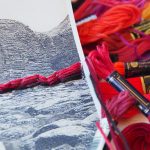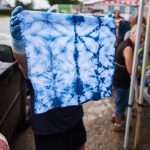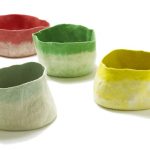You guys know that I love everything to do with fabric and textiles, right? I’ve always been fascinated by artisanal textiles, and one of my favourite things to do on vacation is find some locally-made fabrics or fibres to take home. I’ve bought embroidery in Mexico, yarn in Scotland, weaving in Newfoundland, hand-died fabric in India… it’s all such fun to work with and admire in our home! I’ve done some sewing projects here on Flourish & Knot over the years (find them here), but I’ve always been curious about the production side of things. How are natural fibres harvested, processed, and then turned into the raw materials for DIY projects? Well, when I was approached by the TWIST Fibre Festival, I jumped at the chance to have exactly these questions answered, and to learn more about the many faces of textile art.
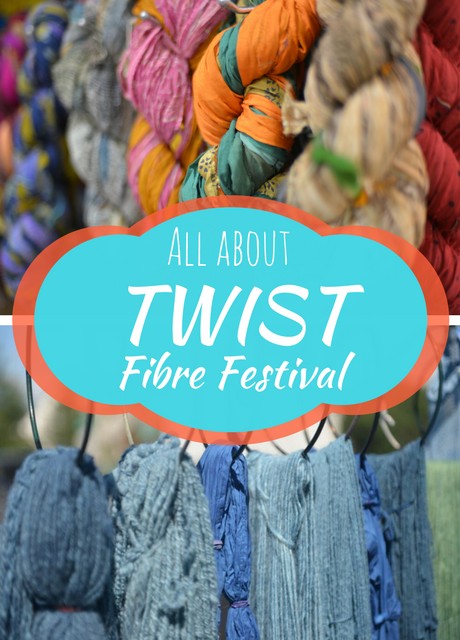
This post was sponsored by the TWIST Fibre Festival. All opinions are my own. For more information, please see my Policies page.
With four days of programming (two days devoted just to workshops, and two days of the full festival), Twist is the largest fibre and textile art festival in Canada. It takes place in the charming Quebec village of Saint-André-Avellin, which is just about 40 minutes north of Ottawa, two hours from Montreal, and two hours from the US border! The area is home to some of the best outdoor activities around, including Parc Oméga wildlife park and Montebello.
So what about these four days of programming? Well, there are over fifty hands-on workshops from which to choose (these are separate from the festival and you need to register in advance), with topics ranging from fabric and wool dyeing, to embroidery and beading, to spinning (the wool kind, not the sweaty gym kind), to felting and more. The festival itself takes place on Saturday and Sunday August 19th and 20th, and includes a huge variety of activities. I spoke with the founder of the festival, Amélie Blanchard, to learn more about Twist and what sets it apart from other festivals.
An interview with TWIST founder Amélie Blanchard
F&K: Hi Amélie! It’s great to be chatting with you about Twist – I’m looking forward to introducing your festival to my readers. Let’s start with a bit about you: what’s your background in textile and fibre art?
AB: I came to fibre later in life. I used to work as a documentary producer in Montreal, then, In 2008, my husband and I decided to buy a farm, to live a different experience away from the city. We had two goats, and then I discovered that cashmere came from goats! So we bought some cashmere goats. I didn’t know anything about fibre! I did a two-day programme in Alberta to learn to analyze and classify it. When I was there there were all these twenty-year-olds walking around with spinning wheels… I was like “isn’t that supposed to be tacky? But it looks really cool!” So we did a sheep-to-shawl night: I was in a team and they showed me how to card. When I came back home I met a woman who taught me how to spin and I really got into it. And I wondered: are there any festivals around here? And there weren’t. So I started Twist! That was six years ago, and now it’s become a big festival!
F&K: Do you work with your own wool?
AB:I harvest the fibre in March. I brush it off and then I send it to a mill. I get back just the cashmere and then I spin it. I just like to go to what I call “Fibre Land”. I like going in my little space – when I have time – and spinning, washing, dyeing the wool. Smelling it!
F&K: Natural wool definitely has such a captivating scent. So tell me a little more about Twist: who attends the festival?
AB: Mostly women – it’s run by women, too! But we get some men and that’s always great to see. One of our aims this year is to have more international visitors and more men!
Our festival-goers are people who totally love textile, but also the people who tag along with them. There’s something for everyone. There are lots of activities for kids – they can discover textile and do lots of things with their hands.
F&K: I’d love to hear a bit more about your « other » programming – the stuff for people tagging along.
AB: Besides our 50 workshops, we also have demonstrations of different fibre arts. We want to promote local farmers with our foodie fair, and we also have a beer garden! There are demonstrations of the mechanical side of some of these arts, too: knitting machines, looms. And there are lots of kids’ activities. They can make their own skipping rope – it’s really cute! We also have a sheep herding demonstration, which is pretty different!
The demonstrations are kind of like teasers. They will let you discover some different textile arts and let you see if you really like something before you invest in classes and equipment. We have needle felting, how to transform linen, how to work a loom, how to make pompoms, how to work a circular sock machine. Kids would also be interested in the demonstrations – they can even learn to make cheese!
F&K: You mentioned wanting to reach a more diverse clientele. What cultures and traditions are represented within your programming?
AB: We have a traditional Québecois weaving form, the ceinture flêché. We also have a workshop on shibori dyeing from Japan.
F&K: Your social media brunch sounds like such a cool idea, bringing together traditional fibre arts with modern social media networking. Tell me a little more about it and why you felt it deserved a place in your programming.
AB: Twist wouldn’t exist without social media because the reality of textile is that it’s a loner thing – but we’ve built a beautiful community online. We want them to be able to meet each other in real life! We’ll also have four live podcasts – two in English and two in French.
F&K: Let’s talk about that loner culture… Because even a hundred years ago these crafts weren’t done alone, they were a community event. I’m curious how you see the modern textile and fibre community evolving.
AB: For sure there are lots of “Stitch ‘n B*tch” groups that get together to knit, but there’s more and more activities for people to do together. Spin-ins, knit-ins, things that bring people together.
F&K: What sets Twist apart?
AB: To me, the originality of the programming, and the amount of activities. We even carefully select our vendors because we want it to be refreshing and inspiring.
F&K: Are you still looking for volunteers for your festival? How can people get in touch with you to volunteer?
AB: You can be a translator for workshops, help out the teachers, work the cash, co-ordinate with festival goers. We give you a pass for the weekend and there’s always food! It’s really fun. Everyone is so happy to be there. I forget every year why I do this… but then the festival happens and everything comes together – everyone is ecstatic!
Volunteer HERE!
F&K: It sounds amazing – and a great place to volunteer. Let’s talk a little about the textile and fibre world. You’re someone who is in tune with what’s happening in textile art. What kinds of trends are you seeing these days?
AB: I think more and more people are using natural fibres and it’s becoming trendier. The goal of the festival is promote natural fibres, and also farms that are raising animals for their fibre. I see more people using natural fibres.
F&K: If someone has just a few hours or even minutes in a week to start a new textile hobby, what would you recommend?
AB: Knitting is really the easiest because all you need are two needles and some yarn. You can get a pretty inexpensive spindle and start twirling away and making some yarn. You don’t need a $1000 spinning wheel – you can learn to make yarn with a small tool. You can learn to weave on a small square peg loom. Needle felting is another great idea – it’s very approachable. You can also try all of this at our festival – people will be so excited to show you! There’s a booth at our festival called “Dr. Knit” and there are people there to help you out for free!
F&K: Do you do any other crafts or DIY hobbies?
AB: I love painting, and taking an old piece of furniture and making it look great again – but I don’t have a lot of time!
F&K: Thanks, Amélie for telling me about your incredible festival! Good luck with the final days of planning!
*Please note that this interview was edited for length and clarity.*
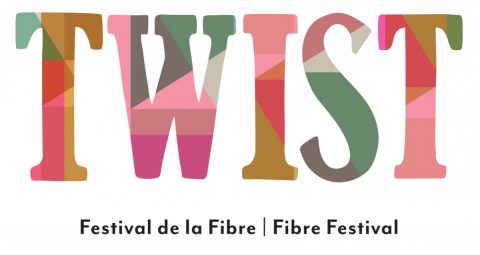
If you are interested in learning more about TWIST, you can visit them on the web (in English and French). There’s still time to register for workshops or to volunteer. Here are some of the workshops I think would be really interesting for Flourish & Knot readers:
- Postcard Hijacking Workshop
- Shibori Dyeing Workshop
- Needle-Felted Bowl Workshop
Find all the workshops HERE!
I’d love to know what areas of textile art interest you: do you like sewing or quilting (Amélie promised some quilting workshops in coming years!), fabric dyeing, knitting, crocheting, felting…? Or maybe you have yet to discover the richness of textile art? Let me know in the comments!
I’m hoping to get to the festival to check out the many demonstrations, vendors, food, and to meet other DIYers who share a love of textile art. Hope to see you there!


